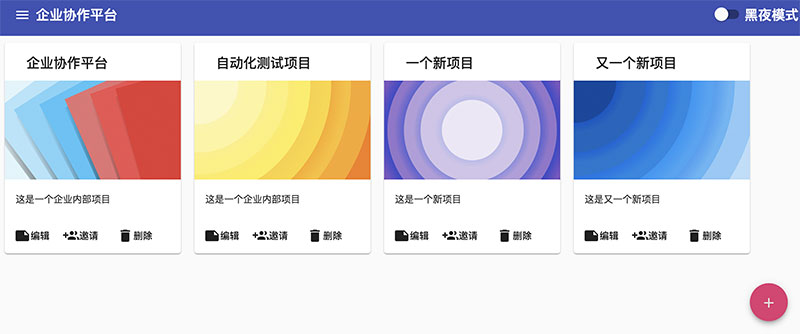您好,登錄后才能下訂單哦!
您好,登錄后才能下訂單哦!
小編給大家分享一下Angular路由動畫及高階動畫函數的示例分析,希望大家閱讀完這篇文章之后都有所收獲,下面讓我們一起去探討吧!
路由動畫需要在host元數據中指定觸發器。動畫注意不要過多,否則適得其反。
內容優先,引導用戶去注意到某個內容。動畫只是輔助手段。
在router.animate.ts中定義一個進場動畫,一個離場動畫。
因為進場動畫和離場動畫用的特別頻繁,有一個別名叫:enter和:leave。
import { trigger, state, transition, style, animate} from '@angular/animations';
export const slideToRight = trigger('routeAnim',[
state('void',style({'position':'fixed','width':'100%','height':'100%'})),
state('*',style({'position':'fixed','width':'100%','height':'80%'})),
transition('void => *',[
style({transform:'translateX(-100%)'}),
animate('.5s ease-in-out', style({transform:'translateX(0)'}))
]),
transition('* => void',[
style({transform:'translateX(0)'}),
animate('.5s ease-in-out', style({transform:'translateX(100%)'}))
]),
]);在project-list中使用路由動畫。
import { Component, OnInit , HostBinding } from "@angular/core";
import { MatDialog } from "@angular/material";
import { NewProjectComponent } from "../new-project/new-project.component";
import { InviteComponent } from '../invite/invite.component';
import { ConfirmDialogComponent } from '../../shared/confirm-dialog/confirm-dialog.component';
import {slideToRight} from '../../animate/router.animate'
@Component({
selector: "app-project-list",
templateUrl: "./project-list.component.html",
styleUrls: ["./project-list.component.scss"],
animations:[
slideToRight
]
})
export class ProjectListComponent implements OnInit {
@HostBinding('@routeAnim') state;
projects = [
{
name: "企業協作平臺",
desc: "這是一個企業內部項目",
coverImg: "assets/images/covers/0.jpg"
},
{
name: "自動化測試項目",
desc: "這是一個企業內部項目",
coverImg: "assets/images/covers/2.jpg"
}
];
constructor(private dialog: MatDialog) { }
ngOnInit() { }
openNewProjectDialog() {
// this.dialog.open(NewProjectComponent,{data:'this is a dialog'});
const dialogRef = this.dialog.open(NewProjectComponent, {
data: { title: '新建項目' }
});
dialogRef.afterClosed().subscribe((result) => {
console.log(result);
});
}
lauchInviteDialog() {
const dialogRef = this.dialog.open(InviteComponent);
}
lauchUpdateDialog() {
const dialogRef = this.dialog.open(NewProjectComponent, {
data: { title: '編輯項目' }
});
}
lauchConfimDialog() {
const dialogRef = this.dialog.open(ConfirmDialogComponent, {
data: { title: '編輯項目', content: '您確認刪除該項目嗎?' }
});
}
}在task-home中使用路由動畫。
import { Component, OnInit , HostBinding } from "@angular/core";
import { NewTaskComponent } from "../new-task/new-task.component";
import { MatDialog } from "@angular/material";
import { CopyTaskComponent } from "../copy-task/copy-task.component";
import { ConfirmDialogComponent } from "../../shared/confirm-dialog/confirm-dialog.component";
import { NewTaskListComponent } from "../new-task-list/new-task-list.component";
import {slideToRight} from '../../animate/router.animate';
@Component({
selector: "app-task-home",
templateUrl: "./task-home.component.html",
styleUrls: ["./task-home.component.scss"],
animations:[
slideToRight
]
})
export class TaskHomeComponent implements OnInit {
constructor(private dialog: MatDialog) {}
@HostBinding('@routeAnim') state;
ngOnInit() {}
launchNewTaskDialog() {
// this.dialog.open(NewTaskComponent);
const dialogRef = this.dialog.open(NewTaskComponent, {
data: { title: "新建任務" }
});
}
lauchCopyTaskDialog() {
const dialogRef = this.dialog.open(CopyTaskComponent, {
data: { lists: this.lists }
});
}
launchUpdateTaskDialog(task) {
const dialogRef = this.dialog.open(NewTaskComponent, {
data: { title: "修改任務", task: task }
});
}
launchConfirmDialog() {
const dialogRef = this.dialog.open(ConfirmDialogComponent, {
data: { title: "刪除任務列表", content: "您確定要刪除該任務列表嗎?" }
});
}
launchEditListDialog() {
const dialogRef = this.dialog.open(NewTaskListComponent, {
data: { title: "更改列表名稱" }
});
dialogRef.afterClosed().subscribe(result => console.log(result));
}
launchNewListDialog() {
const dialogRef = this.dialog.open(NewTaskListComponent, {
data: { title: "新建列表名稱" }
});
dialogRef.afterClosed().subscribe(result => console.log(result));
}
lists = [
{
id: 1,
name: "待辦",
tasks: [
{
id: 1,
desc: "任務一: 去星巴克買咖啡",
completed: true,
priority: 3,
owner: {
id: 1,
name: "張三",
avatar: "avatars:svg-11"
},
dueDate: new Date(),
reminder: new Date()
},
{
id: 2,
desc: "任務一: 完成老板布置的PPT作業",
completed: false,
priority: 2,
owner: {
id: 2,
name: "李四",
avatar: "avatars:svg-12"
},
dueDate: new Date()
}
]
},
{
id: 2,
name: "進行中",
tasks: [
{
id: 1,
desc: "任務三: 項目代碼評審",
completed: false,
priority: 1,
owner: {
id: 1,
name: "王五",
avatar: "avatars:svg-13"
},
dueDate: new Date()
},
{
id: 2,
desc: "任務一: 制定項目計劃",
completed: false,
priority: 2,
owner: {
id: 2,
name: "李四",
avatar: "avatars:svg-12"
},
dueDate: new Date()
}
]
}
];
}定義路由
<mat-list-item [routerLink]="['/project']"> <mat-icon mat-list-icon svgIcon="projects"></mat-icon> <h5 mat-line>項目首頁</h5> <p mat-line mat-subheader> 查看您的所有項目</p> </mat-list-item> <mat-list-item [routerLink]="['/task']"> <mat-icon mat-list-icon svgIcon="projects"></mat-icon> <h5 mat-line>任務首頁</h5> <p mat-line mat-subheader> 查看您的所有項目</p> </mat-list-item>
注意:一定要用HostBinding形式。
用于同時進行一組動畫變換
group([animate(...),animate(...)...])接收一個數組,數組里寫多個動畫。
import { trigger, state, transition, style, animate, group} from '@angular/animations';
export const slideToRight = trigger('routeAnim',[
state('void',style({'position':'fixed','width':'100%','height':'80%'})),
state('*',style({'position':'fixed','width':'100%','height':'80%'})),
transition(':enter',[
style({transform:'translateX(-100%)',opacity:'0'}),
group([
animate('.5s ease-in-out', style({transform:'translateX(0)'})),
animate('.3s ease-in', style({opacity:1}))
])
]),
transition(':leave',[
style({transform:'translateX(0)',opacity:'1'}),
group([
animate('.5s ease-in-out', style({transform:'translateX(100%)'})),
animate('.3s ease-in', style({opacity:0}))
])
]),
]);Query用于父節點尋找子節點,把動畫應用到選中元素。非常強大。
Stagger指定有多個滿足Query的元素,每個的動畫之間有間隔。
做一個示例:新建的時候同時新建2個項目,兩個新建出的項目的動畫依次產生,第一個完成后才開始第二個。

建立list.animate.ts
進場動畫,先隱藏起來,通過stagger間隔1000s做一個1s的動畫。
import { trigger, state, transition, style, animate, query, animation,stagger} from '@angular/animations';
export const listAnimation = trigger('listAnim', [
transition('* => *', [
query(':enter', style({opacity: 0}), { optional: true }), //加入optional為true,后面的狀態動畫都是可選的
query(':enter', stagger(1000, [
animate('1s', style({opacity: 1}))
]), { optional: true }),
query(':leave', style({opacity: 1}), { optional: true }),
query(':leave', stagger(1000, [
animate('1s', style({opacity: 0}))
]), { optional: true })
])
]);在project_list中使用
應用query動畫一般都是跟*ngFor在一起的,需要外面套一層div。
<div class="container" [@listAnim]="projects.length"> <app-project-item *ngFor="let project of projects" [item]="project" class="card" (onInvite)="lauchInviteDialog()" (onEdit)="lauchUpdateDialog()" (onDelete)="lauchConfimDialog(project)"> </app-project-item> </div> <button class="ab-buttonmad-fab fab-button" mat-fab type="button" (click)="openNewProjectDialog()"> <mat-icon>add</mat-icon> </button>
修改對應的css
// :host{
// display: flex;
// flex-direction: row;
// flex-wrap: wrap;
// }
//把host改為div
.container{
display: flex;
flex-direction: row;
flex-wrap: wrap;
}修改一下component
import { Component, OnInit , HostBinding } from "@angular/core";
import { MatDialog } from "@angular/material";
import { NewProjectComponent } from "../new-project/new-project.component";
import { InviteComponent } from '../invite/invite.component';
import { ConfirmDialogComponent } from '../../shared/confirm-dialog/confirm-dialog.component';
import {slideToRight} from '../../animate/router.animate'
import { listAnimation } from '../../animate/list.animate';
import { projection } from '@angular/core/src/render3';
@Component({
selector: "app-project-list",
templateUrl: "./project-list.component.html",
styleUrls: ["./project-list.component.scss"],
animations:[
slideToRight,listAnimation //第一步,導入listAnimation
]
})
export class ProjectListComponent implements OnInit {
@HostBinding('@routeAnim') state;
//第二步,改造一下數組,加id
projects = [
{
id:1,
name: "企業協作平臺",
desc: "這是一個企業內部項目",
coverImg: "assets/images/covers/0.jpg"
},
{
id:2,
name: "自動化測試項目",
desc: "這是一個企業內部項目",
coverImg: "assets/images/covers/2.jpg"
}
];
constructor(private dialog: MatDialog) { }
ngOnInit() { }
//第三步,新增元素時hard code一下
openNewProjectDialog() {
// this.dialog.open(NewProjectComponent,{data:'this is a dialog'});
const dialogRef = this.dialog.open(NewProjectComponent, {
data: { title: '新建項目' }
});
dialogRef.afterClosed().subscribe((result) => {
console.log(result);
this.projects = [...this.projects,
{id:3,name:'一個新項目',desc:'這是一個新項目',coverImg:"assets/images/covers/3.jpg"},
{id:4,name:'又一個新項目',desc:'這是又一個新項目',coverImg:"assets/images/covers/4.jpg"}]
});
}
lauchInviteDialog() {
const dialogRef = this.dialog.open(InviteComponent);
}
lauchUpdateDialog() {
const dialogRef = this.dialog.open(NewProjectComponent, {
data: { title: '編輯項目' }
});
}
//第四步,改造一下刪除項目
lauchConfimDialog(project) {
const dialogRef = this.dialog.open(ConfirmDialogComponent, {
data: { title: '刪除項目', content: '您確認刪除該項目嗎?' }
});
dialogRef.afterClosed().subscribe(result=>{
console.log(result);
this.projects=this.projects.filter(p=>p.id!=project.id);
});
}
}Stagger使得在多個元素時候,動畫交錯開,而不是一起。
看完了這篇文章,相信你對“Angular路由動畫及高階動畫函數的示例分析”有了一定的了解,如果想了解更多相關知識,歡迎關注億速云行業資訊頻道,感謝各位的閱讀!
免責聲明:本站發布的內容(圖片、視頻和文字)以原創、轉載和分享為主,文章觀點不代表本網站立場,如果涉及侵權請聯系站長郵箱:is@yisu.com進行舉報,并提供相關證據,一經查實,將立刻刪除涉嫌侵權內容。